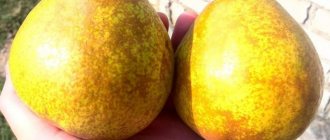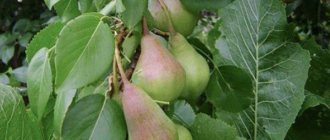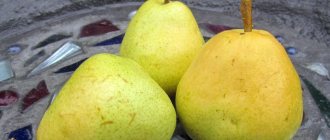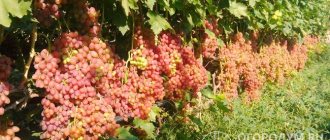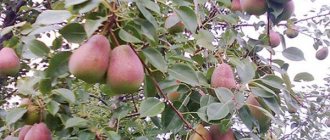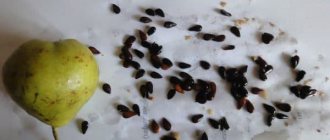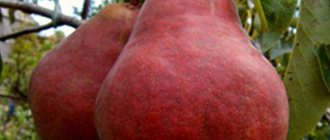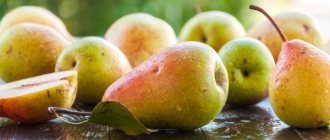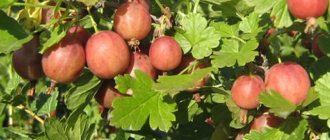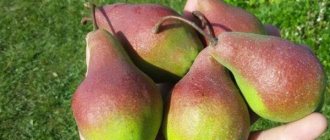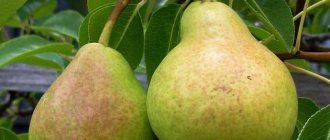Breeders are trying to create pear varieties that are productive, winter-hardy, and resistant to diseases and pests. It is these fruit trees that interest not only beginners, but also experienced gardeners. The description, photos and reviews of the Extravaganza pear presented below will help you decide on the choice of seedlings.
The history of the Extravaganza pear
The authorship of the Feeria variety belongs to the All-Russian Research Institute of Genetics and Selection of Fruit Plants named after. Michurina. S.P. Yakovlev, N.I. Savelyev, V.V. Chivilev worked on the creation of the pear. The varieties Talgar Beauty and Daughter of the Dawn were taken as parents.
Pear Fairy was included in the State Register of Plants of the Russian Federation in 2006. The plant is recommended for cultivation in several areas:
- Belgorodskaya and Oryol;
- Lipetsk and Tambov;
- Kursk and Voronezh.
Although the cultivation of the Extravaganza pear was not limited to the Central Black Earth region. The trees successfully winter and bear fruit in more severe conditions. Gardeners in Perm, Irkutsk, Novosibirsk, and Omsk are successfully breeding the winter-hardy, late-ripening Fairy pear.
Description of the Extravaganza pear
The pear tree stands out for its not too thick, drooping, pyramidal crown. The height of the Extravaganza is 1.5-2 m, sometimes a little higher. The shoots are powerful, arched. The bark on them is brown-brown with a small number of lenticels, without pubescence.
The leaf blades are green, with an emerald tint. The leaves are medium-sized, ovoid in shape with a pointed tip. It is twisted in a helical shape. The leaves are slightly flattened at the base, with small serrations along the edges. The plates are smooth, leathery with a clearly visible shine, with mesh veins. They are attached to a long bare petiole. The shape of the stipules is subulate.
The buds are cone-shaped with a smooth surface. They are a little diverted from escaping.
Characteristics of pear fruits of the Extravaganza variety
Just a description of the trees and a photo of the Extravaganza pear variety will not be enough; you need to know the characteristic features of the fruit.
Extravaganza has large fruits, weighing 125-215 g. The surface of the pears is smooth, slightly oily, but when eaten this feature is almost not felt. At first the fruits are green, by the time they ripen they become amber with a barely noticeable raspberry tint. During storage they acquire a light burgundy color.
Pears hang on an elongated, curved stalk. The funnel is completely missing. The heart resembles an onion, the seed chambers are small and closed. The seeds are dark brown and long. The pulp is tasty, white, juicy, slightly oily, of medium density. Pears are sweet, aromatic, slightly tart. Tasters give the taste 4.5 points out of 5.
Each fruit contains per 100 g:
- soluble substances – 13.3%;
- sugars – 8.6%;
- ascorbic acid – 7.9%;
- p-active substances – 112 ml.
Fruiting begins 5-6 years after planting the seedling. The harvest is harvested in early September. According to gardeners, collecting Extravaganza pears is difficult because it is difficult to determine the stage of ripeness. It is not advisable to keep the fruits on the tree, as this reduces the storage time.
Important! Pears of the Feeria variety, harvested on time, can remain in proper conditions for 4.5-6 months without losing their taste and presentation.
The high yield allows the fruits to be consumed fresh and used to make jam, jam, and compote for the winter.
Plant in open sunny areas
It is better to plant pears in spring. Photo: plodovie.ru
- Plant pear trees in early spring if possible. If this is not possible, then you can plant in the fall.
- Choose a healthy, well-developed seedling. It must have a clearly defined central shoot (smooth) and at least 5 - 6 lateral skeletal branches. The bark is smooth, without damage or signs of disease. The rootstock site is without growths, well healed. The root system is with a strong central root, well developed.
- Dig a hole 80 cm deep and 60 cm wide.
- Place a drainage layer of stones or broken bricks at the bottom of the hole. If the area has a high groundwater table, plant the pear on a pre-filled artificial hill.
- Place a mound of soil mixed with compost or other organic fertilizers over the drainage.
- Place a peg in the hole 5 cm from the center, which will serve as a support for the seedling.
- Lower the seedling into the hole on the north side of the support and straighten the roots.
- Fill the roots in layers, periodically lightly compacting the soil to avoid the formation of voids. Please note that the root collar after planting and watering should be 5 cm above ground level.
- Compact the soil around the trunk, make a groove 5–7 cm deep around the perimeter of the trunk circle for watering.
- Water the seedling, directing the water into the ditch. This way it will not spread and will smoothly seep to the roots.
- Mulch the tree trunk circle after absorbing water with straw, sawdust or humus.
- Tie the seedling to a support. This will help the tree form an even trunk and protect it from the danger of being broken by the wind. Do not use wire for tying, it can damage the bark; do this with a strong rope.
The video shows how to plant a pear tree correctly
Particular attention is paid to placing fertilizers in the planting hole:
Pros and cons of the variety
In addition to the description of the Extravaganza pear variety, photos, reviews, gardeners need to know the advantages and disadvantages. It should be noted that Extravaganza has virtually no disadvantages, mainly advantages:
- The variety is high-yielding and bears fruit consistently.
- The plant is frost-resistant, so the Extravaganza pear can be grown beyond the Urals.
- The fruits are not only beautiful in appearance, but also have an excellent taste.
- Keeping quality and transportability are high, so pear trees of this variety are grown on an industrial scale.
- Strong winds do not cause ripe fruits to fall off.
- The Extravaganza pear is not damaged by many diseases and pests, which greatly simplifies caring for the plant.
- The use of the fruit is universal.
Attention! There are still some disadvantages to the Fairy pear variety: the shoots grow very quickly, and when the crown thickens, the fruits become smaller.
Care
Caring for trees of the Extravaganza variety is not difficult at all:
- Trees need periodic watering. If the summer turns out to be normal with a normal amount of precipitation, then 4-5 waterings per season will be enough. If the weather is hot and dry, then the amount of moisture added is increased;
- keep the ground around the pears clean - remove weeds and organic debris, which may contain pathogenic bacteria, fungal spores and insect larvae;
- the soil must be loosened so that there is access to oxygen to the root system;
- Extravaganza pears love fertilizing, which is carried out three times a season. In early spring, urea is added to the soil, before the beginning of the growing season - nitrogen-containing substances, after flowering - phosphorus and potassium, and in the fall, after harvesting - rotted mullein, bird droppings or humus;
- Every year, tree shoots are shortened in order to thin out and form a crown;
- In the fall, tree trunks are whitened and wrapped in burlap, paper or agrofibre to protect them from rodents in winter.
Planting and caring for the Extravaganza pear
Extravaganza is propagated by cuttings and grafting onto the February Souvenir or Yakovlev's Lyubimitsa varieties. When planting several seedlings, a step of 3.5-5 m is taken between plants so that the branches do not shade neighboring pear trees. The rows are spaced at a distance of 6-7 m.
Caring for the Extravaganza pear comes down to traditional activities; you just need to get acquainted with the basics of agricultural technology.
Landing rules
It is advisable to prepare the area for planting pears in the fall. But if there was no time, the work can be done in the spring. Seedlings are planted early in the spring, before the leaves bloom, or in the fall, so that the plants have time to take root before frost.
The soil is dug up and weed roots are selected. When digging a hole, the soil is thrown on two sides: the upper and lower layers of soil separately. Add organic matter or mineral fertilizers to the fertile soil and mix well.
Rules for planting pears:
- The depth of the pit must be at least 60 cm, width - 80 cm.
- The bottom of the seat is filled with drainage from broken bricks and coarse pebbles. Some gardeners add crushed tin cans.
- Then fill up to half the nutrient composition and fill it with water.
- When the water is absorbed, a mound is made in the center and a seedling with an open root system is placed on it. For container plants, make a depression at the height of the coma.
- Cover the soil, leaving the root collar above the soil surface.
- Afterwards, compact the soil around the trunk and water again.
If the seedlings are weak, then install a support in the center and tie the plant to it. To retain moisture, the tree trunk circle is mulched.
Watering and fertilizing
After planting, the Fairy pear needs to be watered regularly. Subsequent irrigation is carried out before flowering, during fruit ripening and after harvesting. These activities are carried out only in the absence of rain.
Attention! In total, pears are watered 4-5 times during the summer, more often during drought.
Fertilizing and loosening the soil are combined with watering. Pear trees need to be fed 3-4 times a year:
- in the spring you need to add urea;
- before flowering - nitrogen-containing fertilizers;
- at the time of fruit set, phosphorus and potassium supplements will be required;
- After harvesting the pears, the trees are fertilized with humus, a solution of mullein or chicken droppings.
Trimming
For stable fruiting and obtaining pears of the required size, plants require regular pruning. To form the correct crown in the first year, the central trunk of a planted seedling is shortened at a height of 50-60 cm from the ground. Side branches are pruned above the buds.
The next year, the central conductor is also pruned by 20 cm, and the side branches by 5-6 cm. This will make it possible to obtain tiers on the crown: the lower shoots should be shorter than the upper ones.
In subsequent years, pruning is carried out according to the same scheme, with the shoots growing inside the crown removed to avoid thickening and strong shading.
Important! Pruning is planned for the end of March or beginning of April.
Old pear trees undergo rejuvenating pruning. To do this, severe pruning of skeletal or semi-skeletal branches of 5-6-year-old wood is carried out.
Whitewash
In early spring and autumn it is necessary to whiten the trunks and skeletal branches of the Fairy. Before the procedure, the trunk is cleared of old bark, under which insects can accumulate.
Then mix:
- lime;
- copper sulfate;
- wood glue;
- Birch tar;
- hot pepper.
All components are diluted with hot water, and after cooling, whitewashing is carried out.
Comment! The presence of tar and pepper in the mixture protects pears from rodents and aphids.
You can purchase a special whitewash in the store; it already contains the necessary substances to combat diseases and pests that live on the bark of fruit trees.
Preparing for winter
Despite the fact that the Feeria variety is resistant to frost, plants need to be specially prepared for wintering, regardless of climatic conditions.
Seasonal work:
- Pull out weeds, collect carrion and all dry fruits from the tree. Rotten pears found under plants and on branches should be burned.
- Remove all fallen leaves.
- Feed fruit trees with potassium and phosphorus fertilizers to increase resistance to frost.
- If there has been no precipitation for a long time, carry out water-recharging irrigation and then loosen the soil.
- Trim dry branches, clear the trunk of old bark, whiten it and skeletal branches.
- To protect against rodents, tree trunks are wrapped with any non-woven material, burlap (wrap with twine for fixation) or a special mesh.
- The roots are covered for the winter with a thick layer of humus.
- To protect the plantings from frost and wind, as well as to retain snow, experienced gardeners recommend placing inverted barrels on the north side of the pear tree.
Landing rules
By following the rules for planting the Extravaganza pear, you can provide yourself with large harvests for many years
It is important to choose a good place for a young tree, as well as carry out the necessary procedures on time
Recommended timing
You can plant the Fairy pear both in spring and autumn. The site is prepared in advance. In the spring, you need to catch it before the leaves appear, and in the fall, keep in mind that the tree must take root in its new location before frost.
Site selection and soil preparation
Choose a place for the pear that is well-lit, without groundwater close to the surface. It is not recommended to plant trees in lowlands.
The soil is dug up and all weeds are carefully removed. The soil from the lower and upper layers is placed separately. Organics and mineral complexes are added to the pit as needed.
Selection and preparation of seedlings
Before purchasing, seedlings must be checked for damage, both on the trunk and shoots, and in the root system. Before planting, a number of procedures must be carried out. The roots are dipped into the Epin or Matador solution for half an hour. For the purpose of disinfection, seedlings are dipped in a solution of potassium permanganate.
Landing algorithm
The algorithm for planting the Extravaganza pear is as follows:
- dig a hole with a depth of at least half a meter and a width of 80-90 cm;
- It is necessary to make drainage at the bottom; brick chips or pebbles will do;
- the hole is filled approximately halfway with a nutrient composition and filled with water;
- after the moisture has gone into the ground, make a small mound in the center, place a seedling on it and straighten the roots;
- in the case of a plant, a depression is made from the container in accordance with the earthen lump;
- the seedling is covered with soil and compacted without covering the root collar;
- water and mulch.
Advice! If the young tree is weak with a thin trunk, then it needs support.
Diseases and pests
According to the description and reviews of gardeners, the Extravaganza pear is characterized by high immunity. Plants practically do not get sick:
- scab and spotting:
- powdery mildew and rust;
- black cancer and cytosporosis;
- fruit rot.
The pear is not disturbed by such pests as:
- ticks and copperhead;
- pear moth and aphid;
- leaf roller.
But preventive measures should not be neglected. For example:
- In the spring, spray the crown and soil under the pears with special fungicides.
- Clean out cracks and remove old bark with a wire brush.
- Whitewash tree trunks.
- During the growing season, remove all weeds in the tree trunk circle, since this is where pests and disease spores can settle.
- In autumn, spray the crown and branches with fungicides.
Reviews of the pear variety Extravaganza
Viktor Ivanovich Perfilov, 39 years old, Irkutsk.
I’m not much of a gardener yet, since I just started planting the plot with fruit crops. One of the first was the Fairy pear. The description said that the variety is frost-resistant and suitable for our latitudes. Last summer I collected my first harvest - a bucket of delicious fruits. Some of the fruits were eaten fresh, and the rest were put away for storage. We had our own fruits on the New Year's table. They taste even better.
Svetlana Igorevna Titova, 60 years old, Novosibirsk.
I’ve been working on dachas for a long time, but somehow I didn’t dare to deal with fruit trees. About 10 years ago I planted the first apple trees and several pears, one of the varieties called Extravaganza. She liked our frosts: she winters well, bears fruit for 4 years. The fruits have time to ripen. They are tasty, sweet and juicy. Now I have 2 more Extravaganzas on my site. I bought seedlings from a nursery.
Yana Alekseevna Motreva, 45 years old, Moscow region.
I have been growing pears for a long time, but I only planted the Fairy variety last year. I hope it will survive the winter successfully. When I read about the culture, I learned about high immunity and ease of care. I'll see what happens next.
Botanical characteristics and description
The Tavricheskaya pear variety is a plant with a late autumn harvest. This variety is often called winter pear. It has excellent frost resistance and can withstand sub-zero temperatures down to -30°C. Tauride also has good resistance to prolonged drought. The tree of this variety is not too tall, the height of the trunk rarely exceeds 3 m. The crown of the tree has a pyramidal shape, its branches are located at an angle of 45 degrees relative to the trunk and are directed vertically.
Did you know? Like apples, when cut, pears change color and turn brown. This happens due to the fact that the iron contained in the fruits turns into iron oxide upon contact with air. To preserve the natural color of the fruit when cutting, it is recommended to rinse the sliced pears in water with a few drops of lemon juice.
Tavricheskaya has good foliage. The leaves are green, round, smooth, glossy. The tree is self-fertile and does not need pollinating neighbors too much. But if a gardener wants to get abundant annual harvests of Tauride pear, he should plant suitable pollinating varieties in the garden. The variety is compatible with quince, so it is often grafted onto the wild game of this crop.
Tavricheskaya pear is a fast-growing variety. After grafting onto a quince, a young pear begins to bear fruit in the fourth year of the growing season; when growing a seedling from a seed, fruiting begins in the third year. Pear blossoms are abundant and begin in the last days of April or in the first ten days of May. The pear blooms with large white flowers, which emit an intense sweet aroma during flowering, which attracts bees to the flowers. After a week, flowering ends, the flower petals fly off, and in their place a pear ovary begins to form.
The fruits are eaten fresh or prepared from them: jam, compotes are made, or dried fruits are prepared. The fruits of Tauride have the classic pear shape in the form of a wide cone and a lumpy surface. The skin of the fruit is dense, even hard. The pear is bright yellow with a pink blush on one side. The pulp is not grainy, smooth and satiny. The taste of the fruit is sweet and sour, harmonious, very tasty. Pears are medium to large in size, their weight can range from 200 to 600 g. The fruits ripen at the end of September or beginning of October, the harvest time varies depending on the weather. The tree's fruit load is very high, and the yield only increases with age. The pear will produce good harvests for 30 years.
Did you know? For gardeners around the world, Amateur Gardening Day was invented, the first Saturday in May is reserved for its celebration. The purpose of this holiday is to become a symbol of the harmonious unity of man and the plant world.
The first harvest of Tavricheskaya pears will consist of 2–3 fruits. The harvest will gradually increase: from the fifth to tenth year of cultivation, the tree will bear up to 30 kg of fruit; subsequently, an adult tree can produce up to 90 kg of fruit per season. Tauride fruits tolerate long-distance transportation well without losing their appearance and taste. The variety is resistant to falling from branches. The root system of the pear is rather poorly developed, so for the first few years of the growing season it may seem that the seedling is not growing at all. This is not true, because after the tree adapts to a new location, the root system will begin to grow, and the plant will begin to gain above-ground mass.
After ripening, the fruits are held well on the branches and do not fall off
